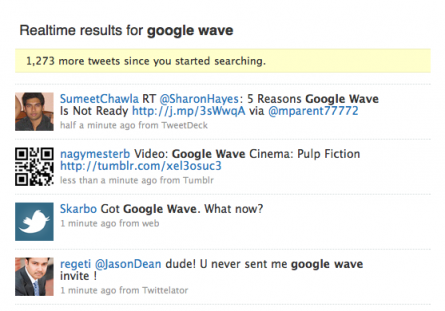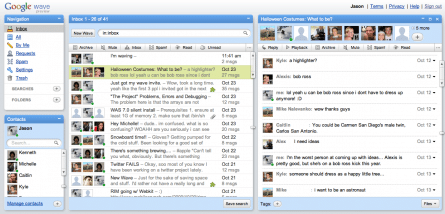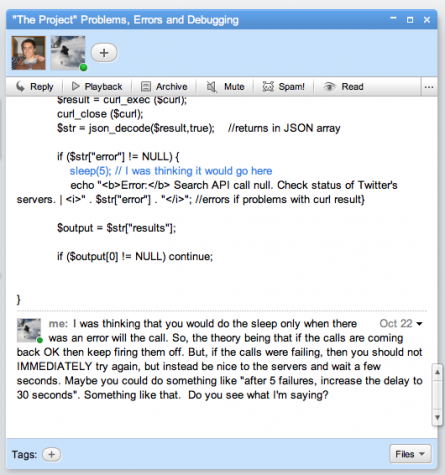

Tons of hype on Twitter around Google Wave
Google has positioned Wave as a new way to communicate and collaborate on the web. Most people are still heavily reliant on email and instant messaging for their online communication. These services have been around for decades and new communication tools have since been invented. Blogs, wikis, and social networks are becoming increasingly popular ways to interact online.  For college students, alternative ways of communicating, like Facebook and text messaging, have already started to replace email. Google Wave hopes to address these issues by providing a completely unique approach integrating email, instant messaging, sharing, and document collaboration into one product.
One of the biggest technologies that Wave is out to change is email. Email has been around forever and many of us use email constantly at work and in our personal lives. Email is good for some things but it can quickly get out of hand. Sometimes it can take 3-4 back-and-forth emails to answer a simple question. Think about how much faster this would be if instant messaging was used instead? Or how about all of those emails that you get CC’d on but don’t care about? The opposite is also possible where you initiate an individual conversation which might be better discussed with a group of people. Wave strives to make all of these situations more clear. It’s extremely easy to start a wave with an individual to ask them a question. If they happen to be online at the time, you can continue the Wave via instant messaging. It’s easy to add other members to the wave if it suddenly becomes of interest to them. Alternatively, you can “Mute” a wave if you no longer wish to be a part of it. Wave blurs the line between these technologies and makes it easier to pick the best one for the situation.
Wave greatly improves instant messaging between friends by adding convenient chat history (”playback”) and a simplified way of doing multi-person chats. The Wave playback feature provides a way to step through the wave history and see exactly when certain events happened. I’ve been using Wave heavily for mult-person chats because it’s just so easy to do! It’s great because you can add new participants to a wave halfway through and they can see the full conversation history. Another nice thing about instant messaging with Wave is that your friends don’t have to be online at the same time. If they are away, you can leave them messages in the wave for later. Wave adds the flexibility of email with the convenience and speed of instant messaging.

A multi-way chat discussing Halloween costume ideas
Document sharing and collaboration has never been easier than it is with Wave. I’ve been working closely with @barnoff this month on a Twitter project he started. As he continues to work on the project, he posts code, questions, and ideas for me to review. Since Wave has the ability to edit any of the posts, I have been able to add comments to his code and make tweaks when necessary. We’ve found this to be much easier than working with Google Docs or trying to work with code over iChat.

Collaborating on some code with @barnoff
After using Wave heavily for the past month, I really believe that it has a bright future. I was a bit concerned about it back in September because I wasn’t sure if people would use it. It’s not easy to convince people to use a new tool when they don’t initially see the value it offers. I think the tremendous amount of hype has really helped push Google Wave adoption and I’m very surprised to see almost 20 of my friends already actively using Wave. I expect the Wave invites to keep flowing out as the Wave team continues to improve the scalability of the system. If you haven’t already received a Google Wave invitation, you can request one here. If you have more questions about Wave, please ask in the comments. I’ll be happy to answer what I can.  I hope to see you on Wave soon!

Comments